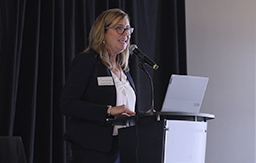Thank you to everyone who joined us at this year’s 17th annual Customer Conference! We had such a great time unmasking the secrets to controlling healthcare costs with old friends and new faces. Our silent auction was a smashing success, too. Thanks to your participation, we raised $7,700 to donate to three deserving community organizations: CHNK, Ohio Valley Goodwill, and Talbert House.
Each year, we bring together experts on the latest trends and hot topics in health care and benefits administration at our conference, so if you missed this one, sign up for our email list to make sure you catch us next year.
Read the highlights and get a glimpse of the exclusive information our speakers shared in the videos below. You can also unlock the full conference presentation here.
What’s New with CDB and TrueCost?
It wouldn’t be the customer conference without some insights from our own Julie Mueller, President and CEO of Custom Design Benefits. Julie shared the latest updates for CDB and TrueCost Reference-Based Pricing.
We also heard from Amanda Guinan, VP, Business Development and Compliance, about the latest cost-containment strategies for pharmacy spend. She unmasked some key aspects of pharmacy benefit management to pay attention to.
Weighing in on Coverage of GLP-1s and the New Era of Weight Loss Drugs
Emerging GLP-1 weight management treatments like Wegovy and Ozempic are hot topics right now. According to a JP Morgan projection, 30 million Americans could be on GLP-1s by 2030. David Lassen of Prime Therapeutics presented on the latest GLP-1 information, including how effective these drugs are, what the future could look like, and what the potential return on investment could be. He also helped us weigh the benefits – and drawbacks – of pharmacy benefit managers covering these expensive medications.
Key takeaways include:
- GLP-1s are being investigated for indications beyond weight loss, like cardiovascular risk mitigation.
- These medications reduce weight by 15-20% but are most effective in conjunction with lifestyle changes.
- GLP-1s are intended for chronic use, meaning that patients are expected to stay on them long-term.
End-to-End Health Benefit Management for Cell and Gene Therapies
At the conference, attendees also got insights on emerging cell and gene therapies from Chris Ford at Emerging Therapy Solutions (ETS). These medications are potentially curative, but they are also the highest-cost therapies the world has ever seen. Not only is the medication itself expensive, but administering this type of therapy often requires hospital stays and other medical care that can compound the cost.
Key takeaways include:
- These medications cost between $2 million to $4.25 million for a single dose.
- Cell and gene therapy administration costs typically range from $300,000 to $800,000.
- The number of approved cell and gene therapies is expected to double in the next 18 months.
How to Manage Pharmacy Spend in a Self-Funded Benefit Plan
Rob Shelley, Founder and CEO of Leaf Health, offered insight into the world of pharmacy and medical rebates. With decades of experience in the pharmaceutical and benefits management industries, he shared expertise on how to keep costs low while maintaining member access and health care quality.
Key takeaways include:
- Medical expenses have traditionally been the largest cost driver for health care, but pharmacy prices are representing more and more expenses in recent years.
- Drug manufacturers are now offering medical (J code) rebates of 2-12% for infusion medications.
- An increase of government activities in drug pricing is expected, which will likely result in more price reductions and fewer rebates.
Demystifying Artificial Intelligence
Conference attendees also got a crash course in artificial intelligence (AI) from Jon Adams of SALIX Data. He shared examples of good use cases for AI, gave information about how AI can benefit businesses, and also offered perspective on its limitations.
Key takeaways include:
- Generative AI relies on “deep learning” – using artificial neural networks to process more complex patterns than traditional machine learning.
- The most successful workforce leverages a combination of human and digital efforts.
- Watch out for “AI Hallucination” – the term for when artificial intelligence outputs false or misleading information.
The Future State of Health Plan Design and Cost Containment
Adam Russo of The Phia Group is always a crowd-pleaser, and this year was no different. He offered a sneak peek at upcoming offerings, gave pro tips for improving member benefit access, and shared his expertise on using data to inform cost containment strategies.
Key takeaways include:
- The average employer spends 1 hour per year discussing health care benefits, but these benefits are the second largest cost for employers.
- Utilization data analysis can help identify risks and opportunities to optimize quality of care while driving down costs.
- Price transparency alone won’t drive better health outcomes, so we also need to review quality metrics.
Want to dive even deeper into health benefit insights and the “Three G’s” (GLP-1s, gene therapy, and generative AI)? Access the conference presentation here.
